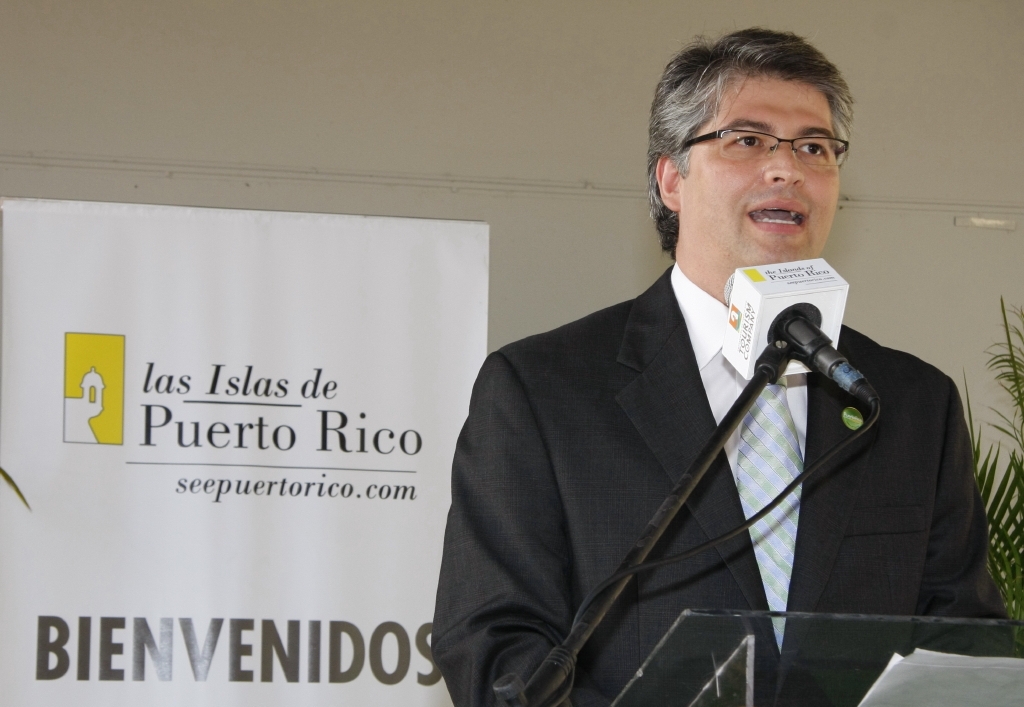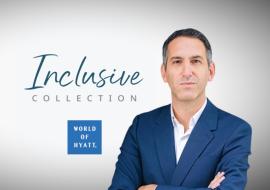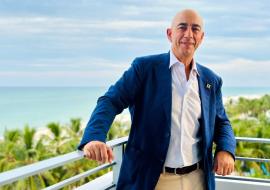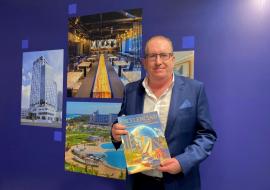Q & A with Mario Gonzalez, Puerto Rico’s Tourism Minister International Destination Expo (IDE) in San Juan, P.R. (April 14-17)

Q & A with Mario Gonzalez
Puerto Rico’s Tourism Minister
International Destination Expo (IDE) in San Juan, P.R. (April 14-17)
By Jose Carlos de Santiago
Q: What has IDE 2011 meant to be for Puerto Rico?
A: This event, more than a fam trip for 700 travel agents, is really an educational experience in which our visitors, our travel agents have learned everything that Puerto Rico has to offer, in the different Puerto Rican regions, on this island of the Caribbean which is far more than just sun and sand. We have our rain forest; we have a 500-year-old history and Old San Juan.
We have a very diverse offer for our tourists, something that makes us the leading Caribbean nation in terms of diversity for tourists. In addition to the new properties that we have opened over the past two years, like the W Retreat & Spa in Viequez; the St. Regis in Rio Grande, which is the first five-star hotel in Puerto Rico. There’s another hotel that will open in November this year in El Condado, and a new lodging currently under construction is the Ritz-Carlton Resort, the first of its kind in the Western Hemisphere, due to open next year.
We’re very pleased of what we are doing in terms of tourism in Puerto Rico and share all this much with our visitors, with these 700 travel agents that are here in Puerto Rico right now. Not too long ago, about a month ago, we were invited by the Travel & Leisure Travel Advisory Board in Miami to present the case of Puerto Rico before them. At the end of that meeting we were told that they see Puerto Rico as an island that’s repositioning itself as a luxury and resort destination, something that we used to be back in the 1980s and the 90s. Yet at some point we lost that glamour as some products closed, especially in Dorado, like the famous Rockefeller Dorado Beach Resort.
We have now a clear vision, with a strategic and well-structured plan to reposition our island the way it used to be: the leader of tourism in the Caribbean.
Q: What do you make of American Airlines’ decision to cut down on the number of flights to Puerto Rico?
A: We’ve just received the first figures for the first quarter of the ongoing year and I must say that we’re 4 percent up from the same quarter a year ago. American Airlines had notified us in October that they were going to pull out some of their flights starting in April, so that gave us some wiggle room to start negotiations with other U.S. airlines.
Their number of seats will be replaced and have to be replaced by other airlines, like JetBlue, AirTrans and others. This is part of AA’s repositioning plan called “Vision 2020” whereby they’ll only keep five hubs in the United States: Miami, New York, Chicago, Dallas and Los Angeles.
The important thing here for the consumer and for the travel agent is that the number of seats overall and the number of seats served by American Airlines won’t be decreased or eliminated. And we’re pleased that other airlines have taken over that space left by American Airlines.
Q: A number of cruise lines are relocating ships outside the Caribbean area and sending them to Europe. Do you think that has to do with lack airlift to the region?
A: We have been keeping very close contacts with major cruise lines, like Royal Caribbean, Carnival and others. That’s not a concern because actually Royal Caribbean, for instance, will relocate one of its vessels out of the Caribbean for 26 weeks during the summer and fall.
They will relocate that ship to Europe, but that’s not the result of lack of air service because in the particular case of that ship around 80 percent of its market share is local, from Puerto Rico. But the bottom line is that for them it’s better to put that ship in Europe during the summer and the fall than down here in the Caribbean. It’s a function of revenue and business.
Q: How much does cruise industry contribute to Puerto Rico’s tourism industry?
A: Cruise lines represent an economic impact of $250 million for Puerto Rico. We welcomed 1.2 million cruise passengers last year, with homeport visitors up a staggering 35 percent. I think we haven’t had a better relationship with cruise lines as the one we have right now. We’re working closely with them and Puerto Rico has an intense program for cruise lines. There’ll be new legislation since the current law will expire on June 30, and we have now included our cruise line partners to help us in passing better, friendlier legislation for cruise lines.
Q: You mentioned Puerto Rico’s diversity at the top of your statement. However, will you consider those who travel on a budget despite your efforts to regain your ground as a luxury destination with five-star resorts?
A: Sure. We’re repositioning ourselves as a luxury and resort destination, yet that does not exclude the fact that we have so many properties that have been around in the travel market for so many years and that really cater to budget travelers. We need to increase our market share and invite an additional market which is not coming to Puerto Rico, like the St. Regis market, which was not coming to Puerto Rico. However, we need to continue our market strategy, with our partners, with the travel agents, in establishing aggressive promotions for those other markets that are so important for us.
Diversity is what actually differentiates us from the rest of the Caribbean islands. The fact that we’re not an all-inclusive destination and we’re a very friendly and quiet destination is what gives us a competitive edge when you compare us with other islands in the Caribbean.
Q: Does the U.S. continue to be Puerto Rico’s top outbound market?
A: The U.S. market accounts for 89.7 percent of all visitors that stay overnight in hotels. For American tourists Puerto Rico means being home, no currency exchange and no passport required.
Other Caribbean islands use tourism as their only economic powerhouse, while Puerto Rico uses tourism as a backup to the island’s economy. Is that a right observation?
A: Exactly. The tourism sector represents approximately 6 percent of the island’s GDP. The manufacturing sector represents approximately 30 to 35 percent of the island’s GDP. However, there’s a very close relationship with business travelers and convention organizers who also travel to Puerto Rico. Business travel represents approximately 35 percent of our market share.
In terms of numbers, tourism for Puerto Rico accounts for $1.8 billion worth of revenue. We have $3.5 billion in annual business transactions and it generates over 50,000 jobs. I mean, within the tourism industry.
Q: How are you faring in the European market? What strategies have you mapped out to capture more tourists from that world region?
A: We have a very well-structured strategic plan. As far as the outbound markets are concerned, our prime market out of Europe is Spain. We have three weekly flights between San Juan and Spain via Iberia, and the airline is planning on adding one more weekly flight during the summer. For the first time in the history of Puerto Rico we’re having a biweekly charter flight with a new Puerto Rican charter airline, flying from Madrid to the west coast of Puerto Rico, to the Aguadilla Airport, and starting May 29 from Barcelona also to the Aguadilla Airport.
We also started receiving British Airways for the first time in eleven years, which came two weeks ago with biweekly flights as well, on Mondays and Wednesdays, and we’re expecting to have an increase of 30,000 additional British visitors via British Airways, while the local charter airline will bring in approximately 11,000 additional passengers from Spain. Starting in December of this year, we’ll have Condor with nonstop flights from Frankfurt to San Juan. That means we’re further diversifying our market base through stepped-up airlift. As a result, this will increase our market base from Europe.
Q: Is that charter flight seasonal or year around?
A: It should be year around. We also have Virgin Atlantic, which is a seasonal service. Virgin Atlantic is a hybrid that uses commercial airlines with passengers buying 14-day packages, broken down in seven days in a hotel and seven days in a cruise. This is a very successful alliance we’ve had over the past seven years with Virgin Atlantic.
How important is the Russian market for Puerto Rico?
A: The Russian market is one that we need to develop. We’ve had talks with the Russian consulate here. Let me give you a little bit of history here. The Russian ambassador to the United Nations came here about a year ago and he visited the whole island. Then he came back with the idea of developing the Russian market here in Puerto Rico.
One of the things we need to do –though we’re already working on that- is be part of some of the trade expos that are taking place in Russia. We need to build alliances with their stakeholders in the travel industry. Our friends from the Dominican Republic are ahead of us in that segment. They receive seven charter flights from Russia every week during some seasons of the year. They are heavily involved not only in traveling but also in purchases. It’s definitely going to be a strong market once we develop it.
Q: What about investments from that market?
A: We have to do some things, like strengthening our European market, our three most important European markets: Spain, the UK and Germany. Ricky Martin is going to perform there and since we’re one of Ricky’s main sponsors on this world tour of his, I think we’ll have a chance to be there as well and carry out some actions.
Q: How actively is Puerto Rico lobbying against the Air Passenger Duty levied on British travelers to the Caribbean?
A: As a member of CTO, you know, CTO is quite involved in lobbying for the reduction of the Air Passenger Duty (APD). That tax has certainly hurt travel from the UK to the Caribbean. We are 33 countries, we’re all CTO members and we’re just one voice. All of us together are against those additional taxes imposed on British travelers crossing the Atlantic Ocean.
Q: The social networks are increasingly playing a role in the way people travel around the world. Is Puerto Rico keeping up with that trend?
A: In terms of marketing and promotional campaigns, we are quite inclined right now to the digital world, to the digital elements, followed by PR efforts and the introduction of advertisement. In less than eight months our Facebook account already has 40,000 friends, which led to an increase on our website of 66 percent. So, we’re very focused on going digital and this is supposed to be a 360-degree turn in marketing and promotional campaigns. And in this particular digital field, we need to keep up with all changes in both technology and consumer trends.
Q: What do you make of Cuba’s opening to the U.S. market and how could this opening have some positive ripple effects on Puerto Rico?
A: President Obama recently announced a partial opening in a number of travel segments, like educational, cultural, religious and sport travel. We see this as a good opportunity, I mean, Cuba’s opening to the U.S. and America’s opening to Cuba. As a matter of fact, the Isla Verde International Airport in Puerto Rico is one of the few airports within American territory that has been allowed to have this kind of travel. So, we see this as a good opportunity for Puerto Rico, for our service providers and for different companies that deliver this kind of service of charter flights in Puerto Rico. This would definitely have a major impact and would also create jobs for people in the region.
Then, in terms of the U.S. opening the leisure market to Cuba, this also ought to be seen as a good opportunity. We have conducted market studies in an effort to check what part of the market share we might lose to Cuba, and it’s a relatively small portion of American travelers. Also as part of the process to branch out our tourist product through more airlift out of Europe and, therefore, more European visitors coming to Puerto Rico, we’re trying to neutralize whatever loss we might have in the U.S. market.
Q: Could Cuba be considered a multidestination offer for Puerto Rico?
A: Puerto Rico is also positioning itself as a multidestination, not only with the Dominican Republic, but also with Cuba. By doing so we give passengers far more options of having other travel experiences.














